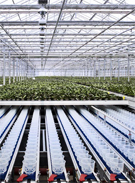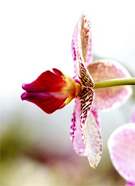No-gas greenhouse
In the heart of the flower zone in the west of the Netherlands, a revolutionary greenhouse is taking shape. Modern cooling and heating technology, groundwater aquifers and environmental care work hand in hand to take Dutch orchid cultivation into the future.
DATE 2023-11-28 AUTHOR Jan Tazelaar The orchid is legendary among the world’s flowers for its beauty and elegance. Like good wine, it takes a long time to develop, but once in full bloom it will enchant admirers for many months.
The orchid is legendary among the world’s flowers for its beauty and elegance. Like good wine, it takes a long time to develop, but once in full bloom it will enchant admirers for many months.
For ages the tropical orchid was only to be seen at royal courts, but then suddenly, towards the end of the 20th century, it made the transition into everyday life. Modern growing techniques made mass production feasible and sparked off a fashion that shows no sign of abating.
The Dutch quickly became one of the world’s leading producers of the exotic flower, having a history of expert cultivation and an impressive infrastructure in place.
The Netherlands is synonymous with flower cultivation, in particular the flower-growing hub of Aalsmeer, a town just south of Amsterdam. One enterprise in this "city of glass" stands out from the rest, and not just for its size. Handelskwekerij Van der Weijden, with its 90,000 square metres of growing surface, is undoubtedly one of the larger orchid growers, but what makes its greenhouses really spectacular are its revolutionary climate control systems. Van der Weijden is one of the first orchid growers to apply the new closed-greenhouse concept developed and patented by Frans van Zaal Totaal Techniek.
Managing Director Lennard van der Weijden, whose grandfather established the company in 1948, says Handelskwekerij Van der Weijden has been concentrating on orchids, mainly the ever-popular Phalaenopsis variety, since 1971.
"The past few years have seen a major expansion of our business," he says. "Because of the ever-growing demand for our flowers, we needed a lot of extra space. That created an excellent opportunity to implement the latest technology in climate control. We knew of a brand new technology that made use of groundwater to store heat or cold, which would enable us to cut our gas heating expenses, while providing a more stable climate in our new greenhouse."
Gas is traditionally used to heat greenhouses in the Netherlands – and a lot is needed. While the Netherlands has significant natural gas reserves, burning fossil fuels is becoming increasingly unpopular from an environmental point of view, due to the CO2 that is released during its use.
fuels is therefore an exciting prospect. The Frans van Zaal closed-greenhouse system not only achieves this aim, but it also uses groundwater to store excess summer heat to be used during winter, thereby cutting energy consumption.
An investment that pays off
Gerard Peek, Commercial Director of Frans van Zaal, introduced long-time customer Lennard van der Weijden to the concept. Peek says, "We had just installed the new system for the first time, and the initial results were extremely promising. But the system is fairly expensive to install in an existing greenhouse, since you have to radically rearrange the interior. Installing it in a new greenhouse dispenses with those additional costs."
 Walking through endless rows of budding orchids in Van der Weijden’s new greenhouse, Peek has the entire air heat exchanger system literally under his feet. The cooling and heating system is made up of numerous rows of convectors and ventilators, which stretch the entire length of the 180-metre-long greenhouse. The metal grids covering it double as a system of catwalks.
Walking through endless rows of budding orchids in Van der Weijden’s new greenhouse, Peek has the entire air heat exchanger system literally under his feet. The cooling and heating system is made up of numerous rows of convectors and ventilators, which stretch the entire length of the 180-metre-long greenhouse. The metal grids covering it double as a system of catwalks.
A grower known for being innovative, Van der Weijden was eager to embrace the concept, and it is certainly paying off. “The investment is high, but I expect to earn it back in eight years,” says Lennard van der Weijden. “We have been up and running for less than a year now, but it seems I am already paying less for my energy than Frans van Zaal predicted. I save over a million cubic metres of gas per year, which equals 0.3 cubic metres per plant. It all leads to a reduction of about 2 million kilograms of CO2 emissions a year. Anybody who seriously cares about the environment would relish such numbers.”
Peek says there are even more advantages to the new system of greenhouse climate control. “Traditionally, climate control in greenhouses was a matter of heating in winter,” he says. “Just like your central heating at home, you would open up the gas burners as soon as the temperature started to drop. This development created opportunities for year-round cultivation of many crops. Much later, cooling in summer made its appearance, which guaranteed even better climate control. But both cost energy, obviously.
“We have developed a system where groundwater serves as an energy buffer and where heating and cooling is distributed much more efficiently throughout the greenhouse.
Many small ventilators
“In older greenhouses you often see huge air heat exchangers with enormous fans hanging from the ceiling. They make an irritating, droning noise and are not very efficient since they heat up the useless top layer of air in the greenhouse. In addition they cast unwanted shadows over the crops.”
The new system, installed at root level, uses many small ventilators to blow the desired hot or cold air directly on the plants. In this way only the air at plant level is conditioned. “While the old air heat exchanger units would use nine watts of electric power per square metre, the new ones use only one watt per square metre. It’s just one of the many energy-saving aspects of the closed-greenhouse concept,” says Peek.
A major component of Frans van Zaal’s patented system is the network of air heat exchangers, which are produced by Alfa Laval’s recently acquired Dutch company Helpman (now called Alfa Laval Groningen). Says sales manager Ad Boiten, “Helpman traditionally sells many air heat exchanger units for greenhouses, and we have a long-standing relationship with Frans van Zaal.
When the closed-greenhouse concept became feasible, our companies started working together to develop a practical system. There are now 268 Alfa Laval Helpman air heat exchangers installed in the Van der Weijden greenhouse. The system is attracting a lot of attention and is certainly going to be a major success among growers.”
The Van der Weijden project, involving installing a closed-greenhouse system in a brand new 15,000-square-metre greenhouse as well as refurbishing the existing 22,000 square metres of existing greenhouse, has been up and running since November, 2007.
Since various systems in the greenhouse, such as transport and automated processing of the plants, are still under construction, the new additions will only reach their full potential this year. Once the greenhouse is completed, Handelskwekerij Van der Weijden expects to deliver no fewer than 75,000 high-quality orchids per week to its many customers in Europe.
“The extension to our facility will more than double our present output towards the end of this year,” says Van der Weijden. “I’m glad that our productivity is already growing. It will be Mother’s Day again before you know it.”
A favourable greenhouse effect
Traditionally, greenhouses in the Netherlands are heated with gas boilers, and if the temperature gets too high the windows are opened. For the past few years, however, the buzzword in horticulture has been the closed greenhouse.
This new concept uses groundwater as a heat buffer. In summer, excess heat in the greenhouse is harvested via heat exchangers and delivered to stored groundwater. Once heated, the groundwater is pumped back into its underground aquifers, where it retains its heat. In the winter months the water is pumped back to the surface, to heat the greenhouse. The groundwater has retained enough heat that electrical heat pumps rather than gas heaters are sufficient to bring it up to the right temperature. One system governs the entire greenhouse climate.
Cooling and heating of the crops is achieved with heat exchangers designed by Alfa Laval Groningen. Says Gerard Peek, commercial manager at Frans van Zaal, “We invited a number of suppliers to help us develop the closed-greenhouse concept. Only Alfa Laval Groningen showed both the ability and the zest to go all the way with us.”
The exchangers are laid out in long rows, at root level, between the growth tables. Ventilators blow warm or cold air up to six metres, directly under the plants’ roots.
This form of cooling/heating ensures a very precisely controlled greenhouse climate and therefore guarantees orchids of the best possible quality. As the windows stay closed, the chance of airborne infections is minimized, which virtually eliminates the use of herbicides.
greenhouse system, however, is the huge potential for energy savings. To begin with, the ventilators use only one-ninth of the energy of their predecessors, and the gas boilers can be completely dispensed with.
Such is the efficiency of the closed greenhouse that in some places the system actually yields an energy surplus. Finally there is a greenhouse effect that is beneficial to the environment.
